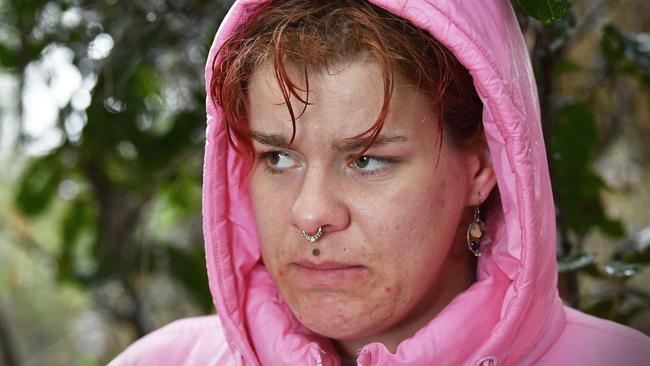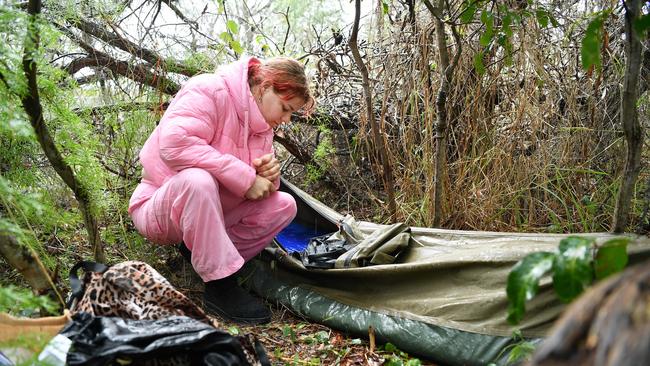Working homeless population growing on the Sunshine Coast
In bushland walking distance from luxury Noosa boutiques a young cleaner is sleeping in a swag, as new figures reveal a shock rise to the “working homeless”.
Property
Don't miss out on the headlines from Property. Followed categories will be added to My News.
It’s a dark and dreary afternoon and Emma Lacey is trying to get the water out of her swag deep in the bushes at the back of Noosa’s Hastings Street.
As the rain pours down and the cold wind comes in from the sea, the downpour might be the closest thing that Emma gets to a shower before she starts work tomorrow morning.
Emma, 23, is a part of a growing population on the Sunshine Coast who are working while homeless.
Walking distance from Noosa’s ritzy main street, Emma’s swag is hidden in bushland where she keeps a “food bag” nearby which thankfully stayed dry during the recent downpour.
Showers are a luxury for the hotel cleaner who works 25 hours a week and washes her clothes at a friend’s house.

“I left Perth due to some extreme circumstances … I wanted to start fresh,” she said.
Emma is hardly alone in her struggles, with the Sunshine Coast Council to vote on a Housing and Homelessness Action Plan at its general meeting.
The report put to council highlights an emerging trend of “working homeless”, with an 11 per cent rise in employed people sleeping rough.
It found homelessness increased 54 per cent from 785 in 2016 to 1205 in 2021.
A major contributor was the tight vacancy rate of just one per cent for rental properties as of January 2023.
The report states 47.1 per cent of renting households on the Sunshine Coast pay $450 or more a week compared to 32.8 per cent in south east Queensland, 25.7 per cent in Queensland and 30.4 per cent nationally.

The council’s action plan includes goals to develop under-utilised and surplus land and buildings for affordable housing.
It also includes support for community-led initiatives to provide for temporary transitional accommodation with appropriate wraparound support services like sleep buses and safe car parks.
Emma had been to the Sunshine Coast five years ago and thought to come here as she was semi-familiar with the area.
“I came and started looking for work immediately and I was lucky to score a job within six days of landing,” she said.
She had looked for house shares online and found a place, but it fell through on the day she was meant to move in.
She said most places were priced way above her budget.
“Just to be able to secure a room I would be left with $37 a fortnight for one room that I was looking at,” she said.
“It’s just not ideal at all to be spending all your money on accommodation and have nothing left to actually live on.”

Emma said not everyone had responded well to her cries for help.
“I’ve had a lot of people be quite judgmental and not understand or suggest I go back to where I came from,” she said.
“I’m not at all trying to take anything away from people who have grown up here their whole lives but it’s not helpful.”
Emma said she just wanted to be a productive member of society and feel safe.
“I want to get up, go work for the money that I earn and live in a house and have some stability,” she said.
“To be able to go back to a house where I feel cosy and warm, safe and secure, and to be able to do that is not as easy.”

The Noosa Council has tried to tackle its housing crisis, releasing its housing strategy in 2022 and mayor Clare Stewart issued a plea for property owners in the region to move their rentals from short-term to long-term accommodation.
Emma has received some support from a friend, who is allowing her to do some washing and shower at his house but she can’t stay there.
“I can’t imagine if someone had no support whatsoever what they would do, I don’t think it would be doable,” she said.
“Imagine trying to get up for work after having a few hours of broken sleep, cold and I wake up soaking wet.
“To be able to hold down a job you need to turn up with some basic hygiene, you can’t just turn up looking all scraggly and gross and stinky.”
Emma has spoken to a number of people who are in the same situation.
“They were working and living in the tray of their ute for six months,” she said.
“There are a lot more people I’ve noticed complaining about ending up in similar circumstances and it’s quite sad.”




